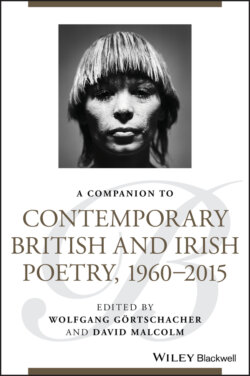Читать книгу A Companion to Contemporary British and Irish Poetry, 1960 - 2015 - Группа авторов - Страница 18
Ted Hughes, “Crow Tyrannosaurus” (1974) (Hughes 1974, 13–14)
ОглавлениеLike all the texts in Crow, this poem has a savage subject matter, the slaughter‐permeated pulse of “Creation.” Crow is a brutish part of this, an avian tyrannosaurus rex. The text is appropriately marked by a violent irregularity. Line length varies—from 3 syllables to 13. The numbers of main stresses per line vary greatly too—from one to five—although, in fact, lines with similar numbers of stresses do cluster in places: for example, in stanza 6 where three‐stress lines enclose a two‐stress one. There is no rhyme, and no metrical regularity. Indeed, beyond noting the numbers of main stresses per line and their variability, there is probably no point in attempting a traditional metrical analysis of the poem. Stanzas 8 and 9 are set out to emphasize fracture. Fixed form has been rejected. It seems a “shapeless cry” (line 12).
But, for all that, there is a surprising degree of regularity in the text. All the first seven stanzas have four lines, and stanzas 8–10 can be seen as retaining something of a four‐based shape: stanzas 8 and 9 together make up four lines, and stanza 10 consists of four phrasal units set out separately. Although the text does not rhyme, there is at least local phonological orchestration. Note the recurrence of /k/ sounds in stanza 1, and of /d/ and /b/ sounds in stanza 4. Note, too, the recurrence of related vowel sounds—/æ/, /ɛ:/, /&ip.iscp;/, and /&ip.iscp;:/—in the last line in stanza 2. There is extensive lexical repetition—“sorrow,” “body,” “weeping,” “Alas,” “grubs,” “stabbed.” There is certainly syntactic parallelism: for example, stanzas 2 and 3. Stanza 7 adopts a parallel “And” structure. Stanzas 8 and 9 are syntactically parallel, and also repeat the same lexis (“weeping” and “stabbed”). Further, order is created by the marked presence of homeoteleuton in the poem: “ing” endings are everywhere in the text, and stanza 10 comes near to rhyming with its repeated “ness” suffix.
The logical coherence and cohesion of the poem is also an orderly element in it. Stanza 1 introduces creation and Crow. Stanzas 2–5 show animal life and human life as death‐bringing. In stanza 6, Crow reflects on all the elements mentioned earlier. Stanza 7 begins with a contradictory “But,” and stanza 10 opens with a consequential “Thus.”
The shapeless “blort” (line 16) that the poem seems at first sight, and, at a certain level, is, is modified by a strong ordering and coherence, by kinds of traditional shaping. The echoes of biblical free verse also give the text a somewhat ordered and traditional quality. But it is the order of savagery, the coherence of stabbing. However, the tensions in the poem's technique might alert the reader to the irony in the text's title. A crow is not a tyrannosaurus. Hyperbole is at play here (as it is in so many of Hughes's beast poems).
